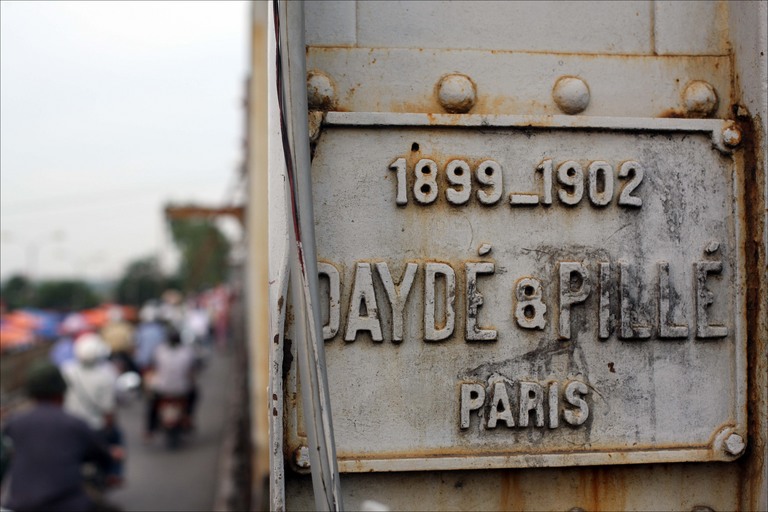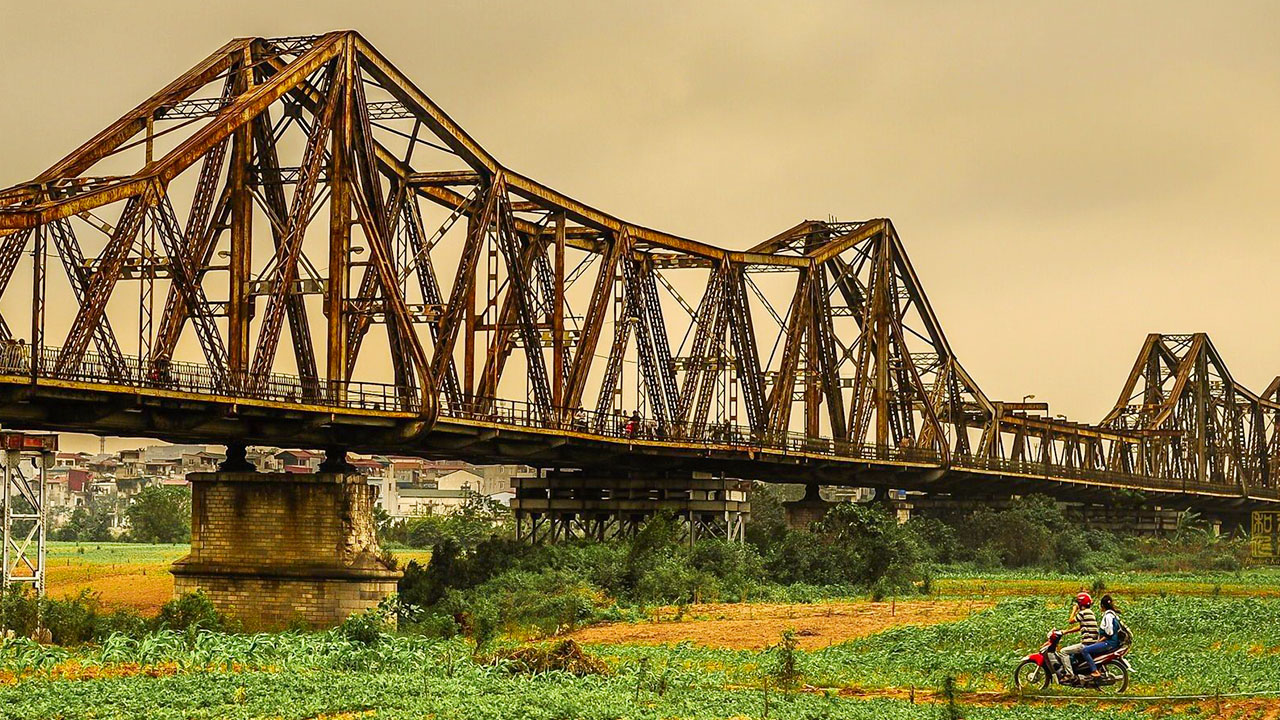In the heart of Hanoi, Vietnam, lies the iconic Long Bien Bridge, an enduring testament to the city’s architectural heritage and unwavering spirit. Constructed in the early 20th century, this cantilever bridge gracefully spans the Red River and seamlessly connects the bustling districts of Hoan Kiem and Long Bien. As you embark on this captivating journey, discover the intriguing history, enduring legacy and captivating beauty of the Long Bien Bridge – a symbol of Hanoi’s resilience and charm.
History of the Long Bien Bridge

Humble Beginnings: The Visionary Architects
- The genesis of the Long Bien Bridge can be traced back to the late 1800s when the need for a robust bridge connecting Hanoi to its eastern suburbs became apparent.
- The responsibility for designing and constructing this vital infrastructure fell upon the renowned architects Daydé & Pillé of Paris, who were known for their expertise in bridge engineering.
- With meticulous planning and precision, they embarked on a project that would forever transform Hanoi’s landscape and serve as a testament to their visionary prowess.
Explore Hanoi Old Quarter
Construction and Opening: A Bridge of Progress

- The construction of the Long Bien Bridge commenced in 1899, a testament to the determination and skill of the engineers and workers involved.
- Over three years of meticulous labor culminated in the bridge’s grand opening in 1903, heralding a new era of connectivity and progress for Hanoi.
- At the time of its completion, the Long Bien Bridge stood as one of the longest bridges in all of Asia, a symbol of Vietnam’s growing infrastructure and modernity.
A Vital Artery during the Vietnam War
- The Long Bien Bridge played a critical role during the tumultuous years of the Vietnam War, serving as a strategic lifeline for the transportation of troops and supplies.
- Its significance as the only bridge across the Red River connecting Hanoi to the vital port city of Haiphong made it a prime target for enemy forces.
- Despite relentless bombing and attacks, the bridge withstood the onslaught, becoming a symbol of resilience and determination amidst the ravages of war.
Resilience in the Face of Adversity
- The Long Bien Bridge bore the brunt of the war’s devastation, with its central span succumbing to an attack in 1967.
- Yet, even in ruins, the bridge’s spirit remained unbroken, with significant portions of its original structure still intact.
- Post-war efforts focused on repairing and rebuilding the damaged sections, preserving the bridge’s historical significance while ensuring its continued functionality.
A Living Relic of Hanoi’s Heritage
- Today, the Long Bien Bridge stands as a living relic of Hanoi’s rich history, a testament to the city’s indomitable spirit in the face of adversity.
- While only half of the bridge retains its original form, it remains an enduring symbol of Hanoi’s resilience and a popular destination for both locals and tourists alike.
Unique Features of the Long Bien Bridge

Architectural Marvel: A Fusion of Styles
- The Long Bien Bridge showcases a captivating blend of architectural styles, reflecting the diverse influences that shaped Hanoi’s history.
- Its riveted steel structure, reminiscent of the Eiffel Tower in Paris, pays homage to French colonial architecture.
- The bridge’s arches and decorative elements, however, draw inspiration from traditional Vietnamese design, creating a harmonious fusion of East and West.
Left-Hand Traffic: A Unique Distinction
- In a city where vehicles typically adhere to right-hand traffic, the Long Bien Bridge stands out as an exception.
- This unique distinction has its roots in the bridge’s original design, which was intended to accommodate both rail and road traffic.
- Today, the bridge remains reserved for trains, motorcycles, bicycles, and pedestrians, making it a distinctive and charming aspect of Hanoi’s transportation network.
Vibrant Market: A Hub of Local Life
- The Long Bien Bridge is not just a historical landmark but also a vibrant hub of local life.
- An open-air market flourishes along the bridge, offering an array of goods, from fresh produce to handmade souvenirs, catering to the daily needs of Hanoians.
- The bridge also serves as a popular gathering spot for locals, who come to enjoy the lively atmosphere and savor mouthwatering street food from vendors lining the walkway.
Wedding Destination: A Backdrop for Romance
- The Long Bien Bridge’s unique charm and historical significance have made it a popular destination for wedding photography.
- Newlyweds flock to the bridge to capture their love amidst the stunning backdrop of the old railway, the flowing river, and the city’s skyline.
- The bridge’s romantic ambiance and timeless beauty provide the perfect setting for couples to commemorate their special day.
Restoration Efforts: Preserving a Legacy
- Recognizing the Long Bien Bridge’s immense historical and cultural value, efforts are underway to restore the bridge to its original grandeur.
- Supported by the French government, the restoration project aims to preserve the bridge’s architectural integrity while ensuring its continued functionality.
- This initiative underscores the importance of safeguarding Hanoi’s heritage and ensuring that future generations can appreciate the bridge’s enduring legacy.
Importance of the Long Bien Bridge

Transportation Hub: Connecting Hanoi’s Districts
- The Long Bien Bridge serves as a vital transportation hub, connecting the Hoan Kiem and Long Bien districts, two of Hanoi’s most populous and economically vibrant areas.
- Its strategic location facilitates the movement of people, goods, and services, contributing to the overall efficiency and prosperity of the city.
- The bridge’s role as a transportation artery is particularly crucial during peak hours, when it helps alleviate traffic congestion and ensures a smooth flow of vehicles.
Historical Significance: A Symbol of Resilience
- The Long Bien Bridge stands as a powerful symbol of Hanoi’s resilience and indomitable spirit in the face of adversity.
- Its survival through numerous wars and conflicts, including the devastating Vietnam War, is a testament to the Vietnamese people’s unwavering determination and courage.
- The bridge’s historical significance is not just a matter of local pride but also a reminder of the resilience of the human spirit in overcoming challenges.
Cultural Landmark: A Source of Inspiration
- The Long Bien Bridge has become an iconic landmark of Hanoi, recognized both nationally and internationally for its architectural beauty, historical importance, and cultural significance.
- Its presence in countless works of art, literature, and music has cemented its place in the collective consciousness of the Vietnamese people.
- The bridge serves as a source of inspiration for artists, writers, and musicians, who find beauty and meaning in its enduring legacy.
Tourist Destination: A Must-Visit Attraction
- The Long Bien Bridge is a popular tourist destination, attracting both domestic and international visitors who come to marvel at its architectural grandeur and historical significance.
- Its unique charm, vibrant market, and breathtaking views of the Red River and Hanoi’s skyline make it a must-visit attraction for anyone exploring the city.
- The bridge offers visitors a glimpse into Hanoi’s rich history, culture, and the resilience of its people, creating lasting memories and a deeper appreciation for Vietnam’s heritage.
Symbol of Unity: Connecting Communities
- The Long Bien Bridge serves as a symbol of unity, connecting not just two districts but also different communities and generations of Hanoians.
- Its role as a public space where people from all walks of life come together fosters a sense of belonging and community.
- The bridge provides a platform for interactions, exchanges, and the sharing of stories, strengthening the bonds that unite the people of Hanoi.
FAQs
1. What is the length of the Long Bien Bridge?
- The Long Bien Bridge spans a total length of 1,682 meters (5,518 feet), making it one of the longest bridges in Vietnam.
- Its impressive length allows it to stretch across the entire width of the Red River, connecting the districts of Hoan Kiem and Long Bien.
2. How old is the Long Bien Bridge?
- The Long Bien Bridge is a testament to engineering excellence and longevity.
- Its construction began in 1899 and was completed in 1903, making it over a century old.
- Despite its age, the bridge remains a vital part of Hanoi’s infrastructure and a beloved landmark for locals and tourists alike.
3. What is the unique feature of the Long Bien Bridge?
- The Long Bien Bridge is renowned for its distinctive left-hand traffic pattern, a unique feature that sets it apart from other bridges in Hanoi.
- This unusual traffic arrangement can be attributed to the bridge’s original design, which accommodated both rail and road traffic.
- Today, the bridge is reserved for trains, motorcycles, bicycles, and pedestrians, creating a charming and nostalgic ambiance.
4. Why is the Long Bien Bridge important?
- The Long Bien Bridge holds immense historical, cultural, and practical significance for Hanoi.
- Its strategic location as the only bridge connecting Hanoi to the port city of Haiphong during the Vietnam War made it a vital transportation route and a target for enemy attacks.
- Today, the bridge stands as a symbol of Hanoi’s resilience and serves as a vibrant hub of local life, with a bustling market and stunning views of the city.
5. What is the current status of the Long Bien Bridge?
- The Long Bien Bridge has undergone significant restoration efforts to preserve its historical and architectural value.
- With the support of the French government, the bridge is undergoing a comprehensive restoration project that aims to maintain its structural integrity while ensuring its continued functionality for trains, mopeds, bicycles, and pedestrians.
- The restoration project reflects the commitment to preserving Hanoi’s cultural heritage and ensuring that future generations can appreciate the bridge’s enduring legacy.
Conclusion
The Long Bien Bridge, with its timeless beauty and enduring significance, stands as a testament to Hanoi’s rich history, resilience, and unwavering spirit. Its architectural grandeur, historical importance, and cultural value make it a must-visit destination for anyone seeking to understand the essence of this vibrant city. As efforts continue to restore and preserve the bridge, it remains a symbol of unity, progress, and the indomitable spirit of the Vietnamese people.





